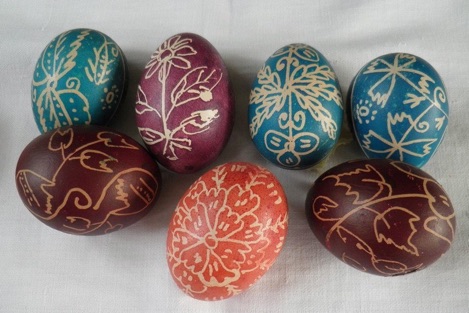The Symbolism of Color
Символіка Кольорів
The Symbolism of Color
Символіка Кольорів


There may be some symbolism to colors used on pysanky, but, if so it is generally secondary to actual motifs used. Color choices were due more to regional preferences (e.g. the color palettes of Bukovyna and Poltava are quite different) and to the availability of dyestuffs (most were locally grown plants). Once a pattern was established, the color scheme was usually preserved, with the exception perhaps of single color eggs; those were often dyed with whatever dyes were available. Often that was a simple onion skin dye; in more modern times, ti would have been quite bright chemical dyes.

Traditional designs and modern dyes, Zavallia, Sniatyn raion, IF oblast
As Vira Manko notes, "the color of a pysanka was also symbolic, although we do not have much in the form of written information about actual symbolism. We can deduce the general archaic meaning of certain colors, but the more colorful a pysanka, the more difficult it is to accurately determine the meaning of the colors." Additionally, different regions interpreted colors differently.
YELLOW Symbolized the moon and the stars and, in farming, the harvest.
ORANGE We cannot assign meaning to the color orange, as the color wasn’t recognized by premodern Ukrainians. They called it “hot yellow.”
GREEN Represented spring, the resurrection of nature, and the riches of vegetation.
RED Perhaps the first recorded color, red initially symbolized blood. It often appears on pysanky with nocturnal and heavenly symbols. Over time, it acquired a positive connotation and began to represent love and joy, as well as marriage. It is associated with the sun.
BLUE Represented the sky or air, and good health.
BROWN Represented the earth.
BLACK Particularly sacred in the color spectrum. It is associated with belonging to the “other world,” but not in the negative sense.
Combinations of colors could also have meanings:
Black and white: respect for the souls of the deceased
Black and red: perceived as harsh and frightful; those with serpent motifs symbolized an earthly deity (not a heavenly one)
Multi-colored: family prosperity, happiness, peace, health and love.
The colors used on a pysanka, like the motifs, were handed down from generation to generation; this determined the colors more than any other factor. Extreme variation from tradition was uncommon.
Back to MAIN Symbolism home page.
Back to MAIN Pysanka home page.
Back to Pysanka Index.